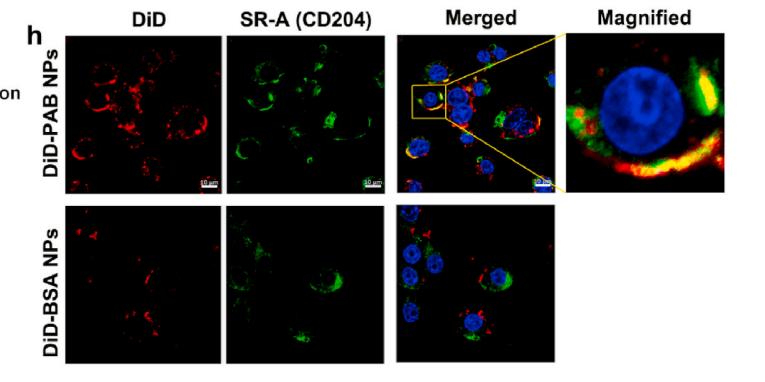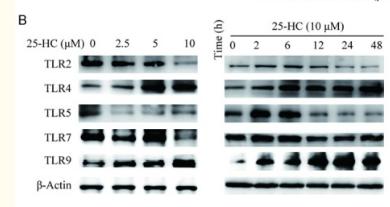TLR7 Antibody - #DF6173
| Product: | TLR7 Antibody |
| Catalog: | DF6173 |
| Description: | Rabbit polyclonal antibody to TLR7 |
| Application: | WB IHC |
| Cited expt.: | WB |
| Reactivity: | Human, Mouse, Rat |
| Prediction: | Bovine, Horse |
| Mol.Wt.: | 121kDa; 121kD(Calculated). |
| Uniprot: | Q9NYK1 |
| RRID: | AB_2838140 |
Related Downloads
Protocols
Product Info
*The optimal dilutions should be determined by the end user. For optimal experimental results, antibody reuse is not recommended.
*Tips:
WB: For western blot detection of denatured protein samples. IHC: For immunohistochemical detection of paraffin sections (IHC-p) or frozen sections (IHC-f) of tissue samples. IF/ICC: For immunofluorescence detection of cell samples. ELISA(peptide): For ELISA detection of antigenic peptide.
Cite Format: Affinity Biosciences Cat# DF6173, RRID:AB_2838140.
Fold/Unfold
PRO285; TLR 7; Tlr7; TLR7_HUMAN; Toll like receptor 7; Toll-like receptor 7; UNQ248;
Immunogens
A synthesized peptide derived from human TLR7, corresponding to a region within the internal amino acids.
Detected in brain, placenta, spleen, stomach, small intestine, lung and in plasmacytoid pre-dendritic cells.
- Q9NYK1 TLR7_HUMAN:
- Protein BLAST With
- NCBI/
- ExPASy/
- Uniprot
MVFPMWTLKRQILILFNIILISKLLGARWFPKTLPCDVTLDVPKNHVIVDCTDKHLTEIPGGIPTNTTNLTLTINHIPDISPASFHRLDHLVEIDFRCNCVPIPLGSKNNMCIKRLQIKPRSFSGLTYLKSLYLDGNQLLEIPQGLPPSLQLLSLEANNIFSIRKENLTELANIEILYLGQNCYYRNPCYVSYSIEKDAFLNLTKLKVLSLKDNNVTAVPTVLPSTLTELYLYNNMIAKIQEDDFNNLNQLQILDLSGNCPRCYNAPFPCAPCKNNSPLQIPVNAFDALTELKVLRLHSNSLQHVPPRWFKNINKLQELDLSQNFLAKEIGDAKFLHFLPSLIQLDLSFNFELQVYRASMNLSQAFSSLKSLKILRIRGYVFKELKSFNLSPLHNLQNLEVLDLGTNFIKIANLSMFKQFKRLKVIDLSVNKISPSGDSSEVGFCSNARTSVESYEPQVLEQLHYFRYDKYARSCRFKNKEASFMSVNESCYKYGQTLDLSKNSIFFVKSSDFQHLSFLKCLNLSGNLISQTLNGSEFQPLAELRYLDFSNNRLDLLHSTAFEELHKLEVLDISSNSHYFQSEGITHMLNFTKNLKVLQKLMMNDNDISSSTSRTMESESLRTLEFRGNHLDVLWREGDNRYLQLFKNLLKLEELDISKNSLSFLPSGVFDGMPPNLKNLSLAKNGLKSFSWKKLQCLKNLETLDLSHNQLTTVPERLSNCSRSLKNLILKNNQIRSLTKYFLQDAFQLRYLDLSSNKIQMIQKTSFPENVLNNLKMLLLHHNRFLCTCDAVWFVWWVNHTEVTIPYLATDVTCVGPGAHKGQSVISLDLYTCELDLTNLILFSLSISVSLFLMVMMTASHLYFWDVWYIYHFCKAKIKGYQRLISPDCCYDAFIVYDTKDPAVTEWVLAELVAKLEDPREKHFNLCLEERDWLPGQPVLENLSQSIQLSKKTVFVMTDKYAKTENFKIAFYLSHQRLMDEKVDVIILIFLEKPFQKSKFLQLRKRLCGSSVLEWPTNPQAHPYFWQCLKNALATDNHVAYSQVFKETV
Predictions
Score>80(red) has high confidence and is suggested to be used for WB detection. *The prediction model is mainly based on the alignment of immunogen sequences, the results are for reference only, not as the basis of quality assurance.
High(score>80) Medium(80>score>50) Low(score<50) No confidence
Research Backgrounds
Key component of innate and adaptive immunity. TLRs (Toll-like receptors) control host immune response against pathogens through recognition of molecular patterns specific to microorganisms. TLR7 is a nucleotide-sensing TLR which is activated by single-stranded RNA. Acts via MYD88 and TRAF6, leading to NF-kappa-B activation, cytokine secretion and the inflammatory response (By similarity).
Endoplasmic reticulum membrane>Single-pass type I membrane protein. Endosome. Lysosome. Cytoplasmic vesicle>Phagosome.
Note: Relocalizes from endoplasmic reticulum to endosome and lysosome upon stimulation with agonist.
Detected in brain, placenta, spleen, stomach, small intestine, lung and in plasmacytoid pre-dendritic cells.
Belongs to the Toll-like receptor family.
Research Fields
· Human Diseases > Infectious diseases: Viral > Measles.
· Human Diseases > Infectious diseases: Viral > Influenza A.
· Organismal Systems > Immune system > Toll-like receptor signaling pathway. (View pathway)
References
Application: WB Species: mouse Sample: macrophages
Application: WB Species: Human Sample: HepG2 cells
Application: WB Species: Mouse Sample: lung
Restrictive clause
Affinity Biosciences tests all products strictly. Citations are provided as a resource for additional applications that have not been validated by Affinity Biosciences. Please choose the appropriate format for each application and consult Materials and Methods sections for additional details about the use of any product in these publications.
For Research Use Only.
Not for use in diagnostic or therapeutic procedures. Not for resale. Not for distribution without written consent. Affinity Biosciences will not be held responsible for patent infringement or other violations that may occur with the use of our products. Affinity Biosciences, Affinity Biosciences Logo and all other trademarks are the property of Affinity Biosciences LTD.




